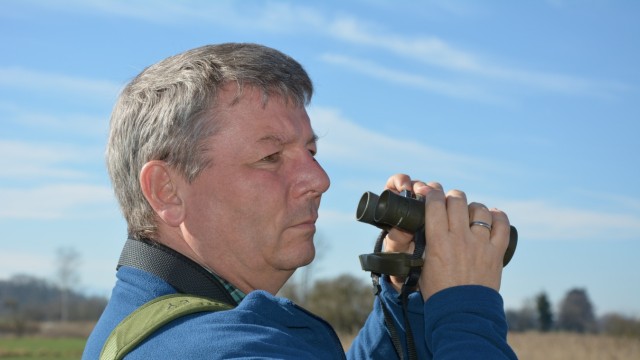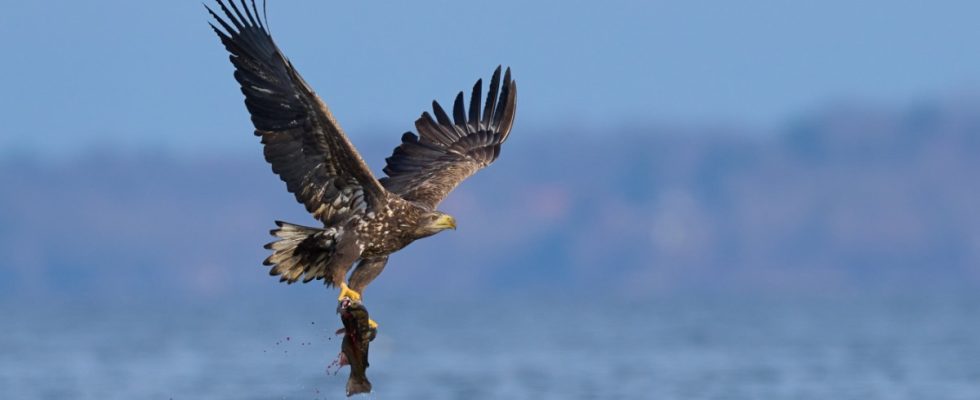The ruler of the bird world is perhaps preparing to take up residence on the southern shore of Lake Ammersee. A young sea eagle was repeatedly observed over a period of three months this winter. It’s not enough to be king of the skies, but at least it’s enough to be a prince: the male bird of prey will only reach sexual maturity in two or three years.
Ornithologists doubt that sea eagles will ever settle in the Five Lakes Region to breed again – even though the species is undisputedly on the rise. It seems more realistic that their distant relatives, the ospreys, will find a permanent home on Lake Ammersee again after more than 100 years. Last summer a male set up a roost on the south bank, but the bride didn’t come.
For a long time, the osprey could be seen with the naked eye from the Dießen bird observation tower at the nest building, says Reinhard Grießmeyer, chairman of the Ammersee-Süd Protection Association (SGA). Of course, he fears that no couple will settle there permanently. The breeding site chosen by the bird of prey near the old bunting is exposed to too much disturbance from boaters and other people seeking relaxation.
The protection community had therefore planned to move the eyrie 200 meters to the south. But to Grießmeyer’s regret, the necessary approval for the resettlement was not received. “This year it will be decided whether he will find a female.” The breeding pairs reacted very, very sensitively to disturbances, especially in the first year. Their return is not expected in the following years.
The conservation community that looks after and maintains the extensive bird and nature reserve on the south bank of Ammersee has already had a failed attempt to resettle ospreys for the first time. After a male was observed spending the summer on the south bank of Ammersee in 2012, four nesting aids were set up on trees between the Wessobrunner and the Andechs ridges the following year with government approval and funding. But none of the artificial nests were accepted. Although they hunt among sailboats on the lake, ospreys are very sensitive during breeding: any disturbance within 200 to 300 meters can cause them to abandon their nest.
An osprey flies to its nest in Everglades National Park in the USA.
(Photo: imago)
The shyness of the large ospreys in this country can be understood historically. Despite all the differences (see box), ospreys and sea eagles share a common fate: centuries of reenactments with traps, guns and poison put an end to both in Bavaria at the beginning of the 20th century at the latest. Nationwide, the species were then brought to the brink of extinction several times through the destruction of habitats and the use of insecticides. In the mid-1960s there were just seven pairs of sea eagles nesting in the Federal Republic; in 1975 the number of ospreys was only 70 pairs. But then surprisingly successful reconquest campaigns began from the North and Baltic Seas.
Today the German osprey population is estimated to be between 500 and 700 pairs. In 1992, a pair bred in Bavaria for the first time in around 150 years. From the Grafenwöhr military training area, the species spreads into the Upper Palatinate and Franconia; the entire population in the Free State is estimated to be around 20 pairs; so far, no successful breeding has been proven in southern Bavaria. But as a migrant, the osprey is now a familiar sight in the Five Lakes Region: The Working Group of Starnberg Ornithologists (ASO) has recorded three to 14 observations in the district every year since 2016. In 2023, ospreys were spotted a total of seven times in April and May as well as August and September, six of them at Lake Starnberg.
The sea eagle can be seen much less often, says ASO chairman Pit Brützel. Almost exactly a year ago, a specimen was spotted on Lake Starnberg on two consecutive days; it was the first observation in the Starnberg district since 2016. But there is still a long way to go before sea eagles actually settle: on Lake Chiemsee, for example, all attempts to provide nesting aids for nesting have failed. The juvenile sea eagle in the southern area of Lake Ammer was first observed in May 2023, says Grießmeyer. This winter, Riederau fisherman Sebastian Hölch spotted the striking bird for a few days in October and the beginning of February, but he doesn’t want to talk about it “overwintering”. The same sea eagle was probably discovered on January 13th at a Lech dam north of Landsberg.
The sea eagle was extinct in Bavaria for 150 years
The nature-loving fisherman does not fear the sea eagle as a competitor for prey, but rather is happy about the rare sight: “It would be a dream if it stayed there,” says Hölch. In the lake’s ecosystem, he sees the large bird of prey “definitely more as a beneficial animal than a pest, which also causes unrest among the cormorants.”
The young bird is already significantly larger than a kite and is almost fully grown. With a wingspan of up to 2.50 meters and a weight of seven kilograms, female sea eagles are the largest European birds of prey, apart from vultures. The Bavarian State Office for the Environment counts it among the “extremely rare species with geographical restrictions”. Haliaeetus albicilla. The majestic bird, a federal eagle symbol of German sovereignty, had already been extinct in Bavaria for 150 years.
The white-tailed eagle has no longer been considered endangered since 1993; Today, with around 1,000 breeding pairs, there are more sea eagles living in Germany than there have been for 200 years – the majority of them, of course, in Mecklenburg-Western Pomerania, Brandenburg and Schleswig-Holstein. The story of the re-entry into Bavaria begins much later and progresses more slowly. In 2001, a sea eagle breeding was detected in the Free State for the first time, and in 2019, 16 Bavarian sea eagle pairs were able to successfully raise offspring. In 2023 there were 32 pairs of sea eagles in Bavaria, one or two of them in Upper Bavaria. In 2022, it was considered a sensation that a pair was breeding in Dillingen on the Danube. There are other breeding grounds at Altmühlsee and the Lower Inn; attempts to establish settlements in Upper Bavaria have failed several times, according to the State Office for the Environment. Sea eagles also need absolute peace, especially during the breeding season, so that they can raise their young.

Pit Brützel is confident that individual breeding pairs of sea eagles and ospreys will settle in southern Bavaria.
(Photo: private)
They can catch fish weighing up to five kilograms, but are usually limited to sick or weakened animals. As food opportunists, they do not disdain carrion, but are also capable of hitting a young fox. Sea eagles prefer to hunt waterfowl; some specialize in finding prey in taking young cormorants from their nests. Even adult gray geese weighing up to four kilograms can be overwhelmed. In 2018, Herrsching’s mayor Christian Schiller came up with the idea of scaring away the annoying water birds from the waterfront with a sea eagle trained to hunt geese. The falconer Miroslav Vrbicky traveled with his impressive bird from the Czech Republic to the Ammersee for a site visit, but the operation failed due to the hunting authorities.

The falconer Miroslav Vrbicky wanted to hunt geese in Herrsching with his sea eagle.
(Photo: Christian Schiller/Herrsching community)
Even if the majestic heraldic bird will probably not be back at home in the densely populated Five Lakes Region any time soon, it will be seen there more and more often as it migrates. Pit Brützel is confident: “I expect that in five to ten years individual breeding pairs of sea eagles and ospreys will have settled in southern Bavaria.”
Species profiles:
Sea eagle
Characteristics: Very large, wingspan up to 2.50 meters, body length up to 92 centimeters. Recognizable in flight by its extended, long neck and board-shaped, fingered wings. Sexually mature birds are predominantly brown with lighter areas on the head, neck, chest and back, white tail feathers, yellow fangs and irises.
Distribution: Worldwide in the northern hemisphere from Greenland to Japan, in Russia and Siberia as a migratory bird. In Germany it is mainly represented in the north, in southern Bavaria there are currently only two breeding pairs at most. Overwintering there on the large lakes is still rare, but the trend is increasing.
Brood: Courtship as early as January, mating in February, breeding from the beginning of February to the end of July, nests on high, old trees, usually two eggs. Horsts up to two meters in diameter and weighing 600 kilograms have been used for decades.
Way of life: Maximum age 40 years, sexual maturity at the earliest at five years, monogamous. Diet: Fish, carrion, waterfowl, smaller mammals.
Osprey
Characteristics: Larger than a kite, with a wingspan of up to 1.80 meters and a body length of up to 65 centimeters. Flight image is reminiscent of seagulls, underside of the entire torso, throat, legs and forearm feathers white, chest with brownish band, beak and claws gray.
Distribution: Worldwide on all continents from the Arctic to the tropics; in Germany largely limited to the new federal states. So far there has been no successful breeding in southern Bavaria.
Brood: Courtship in mid-March, one annual brood between April and July, usually two or three eggs. Nests on tall trees or power lines. Ospreys often use their nests, which measure up to 1.20 meters, for many years.
Way of life: Long-distance migrants, in winter mostly in sub-Saharan Africa, the Mediterranean or southwest Asia. Maximum age 20 to 32 years, sexual maturity at three years, monogamous. Diet mainly fish up to 300 grams, occasionally smaller water birds, amphibians or small mammals.

